Of the many changes COVID-19 has wrought in our lives, one of the most wide ranging has been the change from a physical to a virtual workplace. A year after the pandemic began, a majority of Americans were still working from home, according to U.S. News and World Report. The question on most teleworkers’ minds as the pandemic began to loosen its grip was whether there would eventually be a return to the “bricks and mortar” office. This past weekend, with the removal of the last of the files, archives, machinery, and furniture from our New York City office, that question was definitively answered for Dell Magazines. We’ve gone permanently virtual, although any staff who wish to work in a traditional office can commute to the company’s main office in Connecticut, where our files and archives will henceforth be housed (and where all mail should now be sent—address below).
Given the smoothness with which the entire editorial staff of all of the nearly four dozen Dell magazines (fiction and puzzles) handled the transition to at-home work during the pandemic, one cannot but agree with the decision to close the common workplace. Why continue to hold onto premises that are unlikely ever again to be occupied by a full workforce? And yet, I will confess to some sadness as managing editor Jackie Sherbow and I culled files for the move, then left the office for the last time, knowing that, after thirty years, it was the last time I’d ever set foot in an EQMM office.
The closing of the office required some decisions I never expected to make. With space limited where our archives are going, there was the question of what to do with nearly forty years of early bound issues of the magazine and a nearly-full extra run of EQMM in individual issues. Since my personal collection of EQMMs began with my tenure as editor in 1991, I decided to have the incomplete set of bound issues from the 1940s through 1979 shipped to my home, reasoning that bound issues are easy to house. But then it seemed only logical to complete my set by having the extra single issues from 1980 through 1990 join them. With neither of us wanting to see the remaining issues thrown away, Jackie took quite a number of the other early issues, and places were eventually found to which we could donate the rest. Problem solved.
There is one item, however, that has found a home with me whose source I’d like some help determining. It’s a set of first-day covers of Nicaragua’s commemorative stamps to celebrate the 50th anniversary of INTERPOL. The stamps feature “the twelve most famous fictional detectives”—Peter Wimsey, Philip Marlowe, Sam Spade, Perry Mason, Nero Wolfe, Auguste Dupin, Ellery Queen, Father Brown, Charlie Chan, Inspector Maigret, Hercule Poirot, and Sherlock Holmes. The date is November 13, 1972. This framed set was on the wall of the office I inherited from my predecessor, Eleanor Sullivan, and no doubt hung in every EQMM office from 1972 through Eleanor’s time. It traveled with us in all our subsequent moves, and I did not want to see it end its days boxed up in a storeroom.

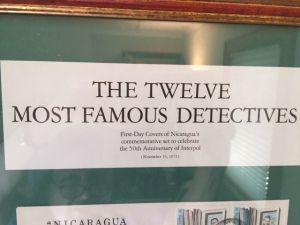
It’s always been my understanding that this wall hanging was a gift to founding editor Frederic Dannay. But from whom? Someone out there must know. If it was sent by someone in Nicaragua, did Fred have it framed—or did it arrive that way? I should have tried to get answers to these questions years ago, when more of the writers from Fred’s day were still with us. My brief recent research has left me unable to identify any mystery writers from Nicaragua of that time who might have had a link to EQMM. In fact, I’m a little mystified by something else: There were, apparently, several countries that issued a single stamp in honor of INTERPOL’s 50th anniversary, but only Nicaragua issued an extensive set. And only Nicaragua pictured fictional detectives on the stamps; the others mainly depicted INTERPOL’s logo or its headquarters. Was the reason for this that Nicaragua was, at that time, a center of mystery-fiction fandom? Everyone knows that several South American countries (especially Argentina and Brazil) have a long tradition of mystery writing and readership, and Mexico does as well. But Central American countries are unknown to me as a source of mystery fiction, and from what I’ve been able to determine, the first translation of a Nicaraguan novel into English occurred in this century. So, if Nicaragua has always been a center of mystery writing and fandom, there must be a wealth of Nicaraguan mystery fiction waiting to be discovered by the English-speaking world.
This one rescued item from our office has, thus, opened my mind to some new thoughts. In addition to causing me to do a little research into Central American literature, it’s gotten me interested in INTERPOL. Although I’d worked under framed documentation of its 50th anniversary for decades, I had never really considered how amazing it is that an international police organization has been in place now for nearly a hundred years (ceasing its intended function only during the years when it was taken over by the Nazis)! INTERPOL’s website says this of its roots: “Our story began in 1914 when police and lawyers from 24 countries first got together to discuss identification techniques and catching fugitives.” Regarding its official inception, they say: “We began as the International Criminal Police Commission, created in 1923, and became the International Criminal Police Organization-INTERPOL in 1956.” So, their 50th anniversary, it seems, was actually in 1973, although the first-day covers for the Nicaraguan stamps were from November 13, 1972.
Can any of you (our readers) tell us more about the commemorative first-day stamps pictured here—or about Nicaraguan mystery fiction? It will be a nice coda to our move if you can!
Any by the way, I’m missing these bound volumes of early EQMMs, if anyone would like to sell them at a reasonable price: volumes 1-5, volumes 9-13, volume 17, volume 49, and volume 52.
All EQMM submissions are now virtual (see our submissions server). But if you need to send us material other than submissions, please use this address:
Dell Magazines/EQMM
6 Prowitt Street
Norwalk, CT 06855
—Janet Hutchings



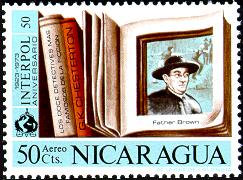

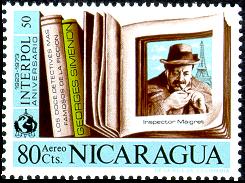

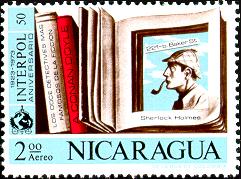
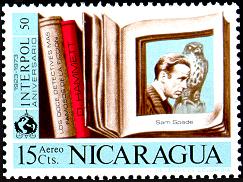

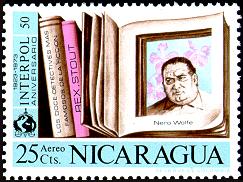
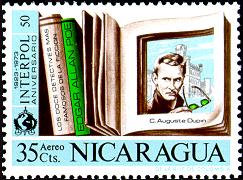


Wow! End of an era. Sad, but it makes sense. And fascinating stuff about the stamps and Interpol. I hope you solve the mystery of the stamp collection.
Do you all know anybody who has a collection of American Detective magazines? (I know, it’s a long shot! *laugh*)
This is fascinating, Janet! Yes, the end of an era, and I imagine there has been a shift in working practices for many people.
This is so poignant, Janet. Leaving after so many years! My uncle worked for Dell starting in the 1940s on a number of their magazines-Modern Screen, Modern Romance-and in the book publishing division. My cousin and I would go to his office, I think near the UN. Large office building and he’d take us for lunch nearby. Often we’d say hello to Mr. Delacorte, a close friend of my uncle’s. It all seemed very grand and a different world from Livingston,NJ. And yes, a different world from now! My uncle would have been very tickled that I was published in EQ!
Stamp story is fascinating…
Thanks, all. And Katherine, I know what you mean about the aura of that era of publishing. My first job in publishing was at Doubleday, when the family still owned it. Nelson Doubleday’s office was on the same floor where I worked. Maybe a little similar to what your uncle experienced at Dell, although I was not at a level to be friends with the publisher!
Thanks for the excuse to go down the rabbit hole in search of Nicaraguan crime fiction. That led me to Sergio Ramírez, an author/intellectual who headed Nicaragua’s Ministry of Education and was Daniel Ortega’s vice president for a few years.
Ramírez doesn’t have a connection to the postage stamps (not that I could find, anyway), but he sometimes writes crime fiction!
His fact-based, historical crime novel Divine Punishment (Castigo divino) won the Spanish Dashiell Hammett prize in 1988 and was issued in English in 2015. More recent are his police procedurals, The Sky Cries for Me (El cielo llora por mí) and No One Cries for Me (Ya nadie llora por mí).
Adding him to my “to buy” list!
Many thanks, Leslie! I’m going to follow up on this writer.
I somehow missed this when it was published last month, Janet, but reading it now I see the change as inevitable but still poignant. I visited the EQMM offices many times in the ‘70s, had many enjoyable conversations with Eleanor Sullivan, Clayton Rawson, Connie Dirienzo and others.
And somewhere I have a set of those Nicaraguan first-day covers! (I wish I could say that I bought two sets and had one framed for Eleanor — and I expect I could get away with it if I were to make that claim! — but, no, it wasn’t me.)
It was me, however, who set my story “The Illusion of Control,” which coincidentally enough appeared in the June 2021 issue of Mystery Weekly, in an elevator in the office building at … 44 Wall Street, a building I don’t imagine I’ll now ever have a reason to visit again….